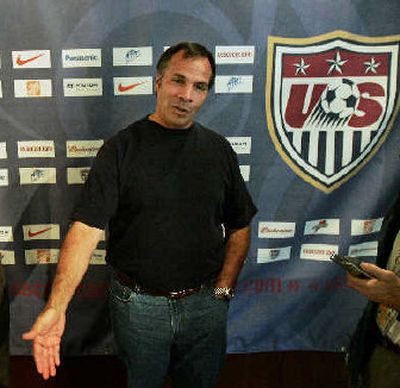Time for a better method

HAMBURG, Germany – Alex Rodriguez occasionally arrives at Yankee Stadium wearing an Arsenal jersey. That’s as close as soccer gets to the top American athletes.
For most teams at the World Cup, their nation’s strongest, fastest and slickest are on the field. For the United States, they’re on baseball diamonds and basketball courts, or in weight rooms preparing for NFL camps.
“We have to do a much better job at broadening the base of elite athletes. Especially in the Hispanic community and the African-American community,” U.S. Soccer Federation president Sunil Gulati said Saturday, two days after the Americans were eliminated in the first round for the third time in their last five World Cups.
For every Landon Donovan, DaMarcus Beasley, Bobby Convey and Oguchi Onyewu that came up through the national team program in the last few years, how many athletes instead play college football or basketball, or minor league baseball?
While today’s team is faster, stronger and more skillful than the past, offense is still sparse. Since returning to the World Cup in 1990 after a 40-year absence, the United States has 15 goals in 18 matches – and three of those were own goals, gifts from opponents.
“We’re still waiting for that great striker to emerge, that guy that Real Madrid say they have to have for $30 million and then he goes and leads La Liga in goals for three, four years in a row,” U.S. goalkeeper Kasey Keller said. “That’s what we’re waiting for.”
In the rest of the world, clubs have youth programs that expose hundreds of thousands of young boys to soccer. Players are identified as possible stars when they are 12 or so, and their careers are nurtured. In America, it’s a lot more complicated.
From 1985-95, there wasn’t a top-level professional league in the United States. Major League Soccer began in 1996, and – to hasten development of younger players – a year later the U.S. Soccer Federation devised “Project 40.”
The program identified the best 40 young prospects, mostly in college, and signed them to pro contracts with an MLS club while putting aside money to complete their education.
“We’re developing our game from the top down instead of the bottom up,” said U.S. coach Bruce Arena, whose return is not assured following the Americans’ early exit from his second World Cup. “That’s a naive approach if you think that we magically select the best 40 players every two years and got it all right and that’s it. We have thousands of kids playing that have a future in this game, and it will only be better if there are better soccer environments year-round.”